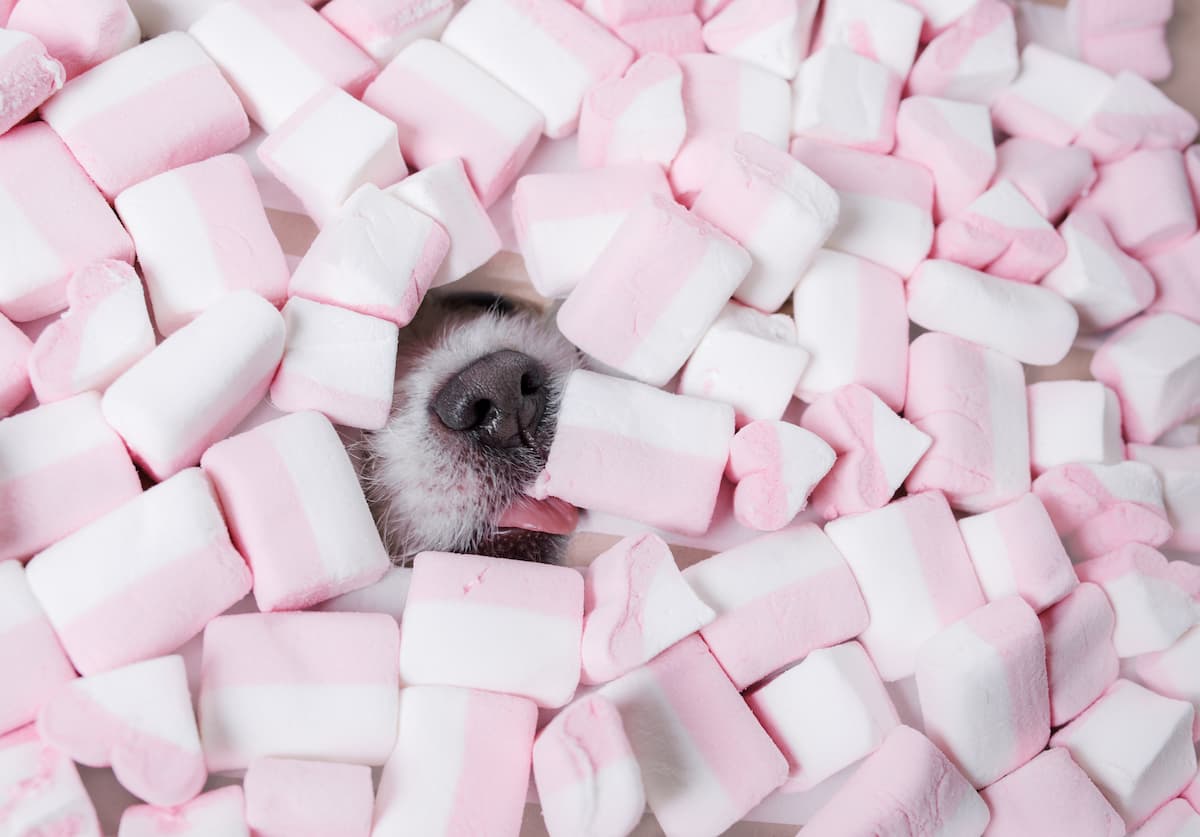Deliciously sweet, roastable, and light as an edible cloud, marshmallows are a dream of a candy. If you don’t have a bag stashed away in your kitchen cabinet right now, consider this your reminder to put marshmallows on the grocery list (sorry about that, and you’re welcome!).
But as irresistible as these squishable mounds of sugar are, can dogs eat marshmallows with you? Are there any benefits to tossing your dog a sweet treat every once in a while or should you stick with healthy dog treats? And what should you do if your dog has sneakily chowed down on a bag of marshmallows while you were away?
Whip up a cup of hot cocoa because we’ve got the answers to all of your marshmallow questions!
Can dogs eat marshmallows?
While most marshmallows are not technically toxic to dogs, the widespread consensus is that dogs should not eat them. Not only do marshmallows offer no nutritional value, but their high sugar content can have both short term and long term negative health effects, such as tooth decay, pancreatitis, heart disease and hypertension.
While your dog may love the taste of marshmallows in the moment, they could start to feel sick to their stomach shortly after their special treat. If you’ve ever overindulged in marshmallows yourself, you know that it’s a quick way to ruin a perfectly good time.
Marshmallows that contain the chemical sweeter, xylitol, do pose a risk of toxicity in dogs and should be considered dangerous. In some cases, xylitol can trigger a drop in blood sugar and strain on the liver that can be life-threatening if not treated.
One other thing to consider with marshmallows is that they can pose a choking hazard to dogs. Because the texture is not hard or crunchy, your dog may try to swallow the whole thing without chewing. This is made worse by the fact that your dog’s sweet receptors are located on the back of their tongue.
Can dogs eat marshmallows as a very special treat?
Given that the majority of marshmallows are not toxic, you don’t have to worry about your dog eating one that fell between the couch cushions. And, if you really feel the need, you can share one or two marshmallows with your furry friend the next time you and the family are roasting marshmallows.
That said, there are better ways to include Fido in on the fun that doesn’t include scrutinising ingredient labels for xylitol and hoping that he doesn’t have digestive discomfort afterwards. You might consider, for example, having a bag of Waggly Treats on hand when your family is enjoying a few marshmallows. In fact, because dogs are more drawn to all-natural, meaty flavours, your dog will probably prefer the taste of their favourite doggy snack to the sweetness of marshmallows.
To be sure, sharing an occasional treat with your dog is a wonderful way to build a strong bond with your pup and provide them with some mental enrichment. You can be sure that your doggo is getting the most out of the experience by giving them treats that are created just for them!
 What should you do if your dog has eaten more than a few marshmallows?
What should you do if your dog has eaten more than a few marshmallows?
A couple of marshmallows here and there isn’t likely to be too much of an issue for your dog. But what should you do if you walk into a kitchen with an empty bag of marshmallows and a very suspicious-looking dog?
Firstly, if the marshmallows contain xylitol, you’ll want to head straight for the vet’s office where they can treat your dog right away.
If the marshmallows did not contain xylitol, your first step will be to call your vet. They may recommend that you come in for immediate treatment before your dog experiences digestive discomfort. Or, they may have you monitor your dog for the following symptoms before coming in:
- Vomiting
- Diarrhoea
- Panting
- Fatigue
- Excessive thirst
Make sure that your dog has access to fresh water and a cool area to recuperate in, and take your dog in if you see any further changes to their health status.
How can you prevent your dog from eating marshmallows in the first place?
Once a dog has developed a taste for marshmallows, they might start to drool at the mere sight of the bag. While you will certainly want to limit their access to this sweet treat and warn their dedicated Dog Sitter to hide away the sweets, there are a few things that you can do to phase out your dog’s marshmallow madness:
- Teach them a generalised “leave it” cue. Teaching your dog to leave food that’s fallen on the ground is a valuable skill, and it can prevent a costly trip to the vet if you happen to drop something that is toxic to your dog
- Provide your dog with foraging outlets. Foraging is a natural doggy instinct that can lead to all kinds of naughtiness when you’re away. By giving your dog supervised opportunities to forage, whether with a fun scent tracking game in the backyard or a snuffle mat, your dog may be less inclined to sniff through your kitchen cabinets
- Address any counter-surfing habits. If your dog has a habit of jumping up on the counters, you probably already know to keep the tasty treats safely out of your dog’s reach. At the same time, proactively teaching your dog not to counter surf by offering them treats for a different behaviour can help to phase out the counter cruising entirely.
Overall, should dogs have marshmallows…yes or no?
Marshmallows range from unhealthy to potentially toxic and should never be considered an appropriate treat for your dog. If they manage to get their chompers on one or two non-xylitol marshmallows (or you simply can’t resist those puppy dog eyes), you don’t have to panic. But, even a few marshmallows here and there can lead to digestive upset and, over time, negative health outcomes.
Instead, give your doggo what they really want, like tasty, all-natural snacks. And work on teaching your doggo not to lunge for the marshmallows with some proactive training. The good news is, more marshmallows for you!

